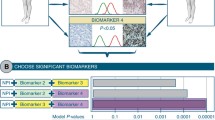Abstract
EpCAM (CD326) has diverse roles in cell adhesion and proliferation, and is known to be overexpressed in primary breast carcinomas (PBCs). While clinical and preclinical data suggest a role for EpCAM in metastases, the only prior study of EpCAM expression in breast cancer metastases suggested that EpCAM expression is decreased after first-line chemotherapy. This study evaluates EpCAM expression in metastatic breast carcinoma (MBC) versus matched PBC . Rapid autopsies were performed on 17 patients with widely metastatic breast cancer. Single patient tissue microarrays (TMAs) were constructed from archived PBC and post-mortem MBCs. In total, 169 spots from 17 PBCs and 895 spots from 195 MBCs were labeled for EpCAM by immunohistochemistry (IHC). Expression was scored as intensity (1–3) multiplied by percent membrane labeling (0–100%) and was subclassified as low (0–100), moderate (101–200), or high (201–300) labeling. PBCs exhibited exclusively low-moderate EpCAM labeling. EpCAM labeling was present in all metastases and was significantly increased in MBCs of 14 of 17 patients (P value range <0.05 to <0.0001, t test). In the remaining three patients, EpCAM labeling was nonsignificantly increased in 1 and unchanged in 2. High EpCAM labeling was verified using a different antibody for IHC, as well as in a separate series of surgically resected metastases compared to unmatched surgically resected primary breast cancers. In conclusion, EpCAM is highly expressed in MBCs compared to matched PBCs, verifying that it is a promising therapeutic target.





Similar content being viewed by others
References
Trzpis M, McLaughlin P, de Leij L, Harmsen MC (2007) Epithelial cell adhesion molecule: more than a carcinoma marker and adhesion molecule. Am J Pathol 171:386–395
Baeuerle PA, Gires O (2007) EpCAM (CD326): finding its role in cancer. Br J Cancer 96:417–423
Armstrong A, Eck SL (2003) EpCAM: a new therapeutic target for an old cancer antigen. Cancer Biol Ther 2:320–325
Sankpal NV, Willman MW, Fleming TP, Mayfield JD, Gillanders WE (2009) Transcriptional repression of epithelial cell adhesion molecule contributes to p53 control of breast cancer invasion. Cancer Res 69:753–757
Gastl G, Spizzo G, Obrist P, Dunser M, Mikuz G (2000) EpCAM overexpression in breast cancer as a predictor of survival. Lancet 356:1981–1982
Spizzo G, Went P, Dirnhofer S et al (2004) High EpCAM expression is associated with poor prognosis in node-positive breast cancer. Breast Cancer Res Treat 86:207–213
Litvinov SV, Balzar M, Winter MJ et al (1997) Epithelial cell adhesion molecule (EpCAM) modulates cell–cell interactions mediated by classic cadherins. J Cell Biol 139:1337–1348
Schmidt DS, Klingbeil P, Schnolzer M, Zoller M (2004) CD44 variant isoforms associated with tetraspanins and EpCAM. Exp Cell Res 297:329–347
Maetzel D, Denzel S, Mack B et al (2009) Nuclear signaling by tumour-associated antigen EpCAM. Nat Cell Biol 11:162–171
Munz M, Baeuerle PA, Gires O (2009) The emerging role of EpCAM in cancer and stem cell signaling. Cancer Res 69:5627–5629
Thurm H, Ebel S, Kentenich C et al (2003) Rare expression of epithelial cell adhesion molecule on residual micrometastatic breast cancer cells after adjuvant chemotherapy. Clin Cancer Res 9:2598–2604
Went P, Dirnhofer S, Salvisberg T et al (2005) Expression of epithelial cell adhesion molecule (EpCam) in renal epithelial tumors. Am J Surg Pathol 29:83–88
Wu JM, Fackler MJ, Halushka MK et al (2008) Heterogeneity of breast cancer metastases: comparison of therapeutic target expression and promoter methylation between primary tumors and their multifocal metastases. Clin Cancer Res 14:1938–1946
Munz M, Kieu C, Mack B, Schmitt B, Zeidler R, Gires O (2004) The carcinoma-associated antigen EpCAM upregulates c-myc and induces cell proliferation. Oncogene 23:5748–5758
Braun S, Hepp F, Kentenich C et al (1999) Monoclonal antibody therapy with edrecolomab in breast cancer patients: monitoring of elimination of disseminated cytokeratin-positive tumor cells in bone marrow. Clin Cancer Res 5:3999–4004
Jojović M, Adam E, Zangemeister-Wittke U, Schumacher U (1998) Epithelial glycoprotein-2 expression is subject to regulatory processes in epithelial-mesenchymal transitions during metastases: an investigation of human cancers transplanted into severe combined immunodeficient mice. Histochem J 30:723–729
Gosens MJ, van Kempen LC, van de Velde CJ, van Krieken JH, Nagtegaal ID (2007) Loss of membranous Ep-CAM in budding colorectal carcinoma cells. Mod Pathol 20:221–232
Steeg PS (2006) Tumor metastasis: mechanistic insights and clinical challenges. Nat Med 12:895–904
Klein CA (2008) The metastasis cascade. Science 321:1785–1787
Chiang AC, Massague J (2008) Molecular origins of cancer: molecular basis of metastasis. N Engl J Med 359:2814–2823
Balic M, Lin H, Young L et al (2006) Most early disseminated cancer cells detected in bone marrow of breast cancer patients have a putative breast cancer stem cell phenotype. Clin Cancer Res 12:5615–5621
Shipitson M, Campbell L, Argani P et al (2007) Molecular definition of breast tumor heterogeneity. Cancer Cell 11:259–273
Acknowledgments
Special thanks to all of the patients and families whose selfless generosity made this research possible, and to the tissue microarray laboratory of Dr. Angelo DeMarzo at the Johns Hopkins Hospital. This study was supported by DOD Center of Excellence W81XWH-04-1-0595, and NIH P50 CA88843.
Author information
Authors and Affiliations
Corresponding author
Electronic supplementary material
Below is the link to the electronic supplementary material.
Rights and permissions
About this article
Cite this article
Cimino, A., Halushka, M., Illei, P. et al. Epithelial cell adhesion molecule (EpCAM) is overexpressed in breast cancer metastases. Breast Cancer Res Treat 123, 701–708 (2010). https://doi.org/10.1007/s10549-009-0671-z
Received:
Accepted:
Published:
Issue Date:
DOI: https://doi.org/10.1007/s10549-009-0671-z




